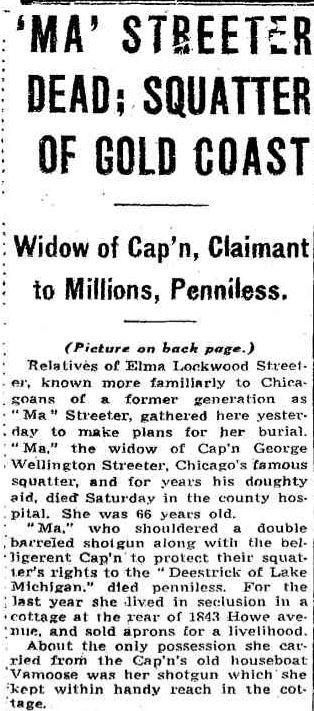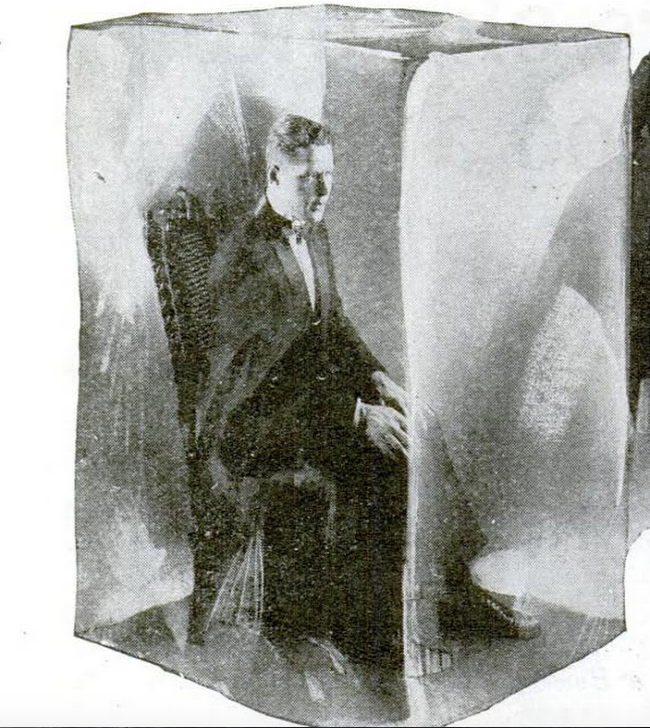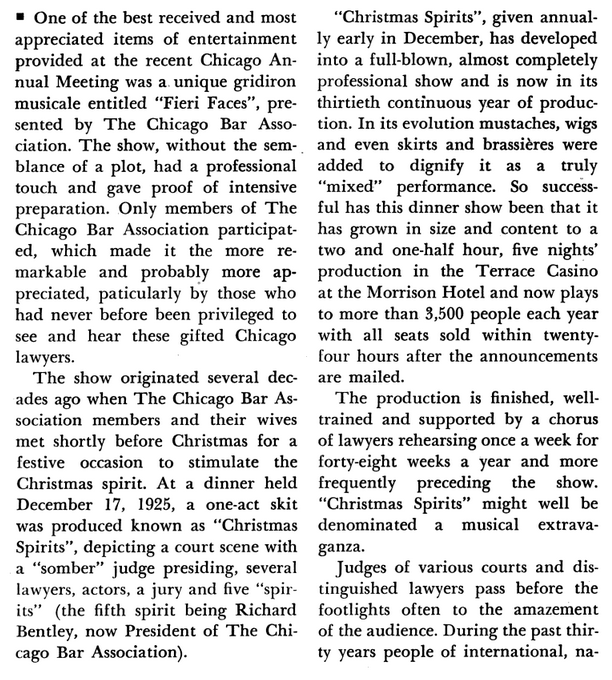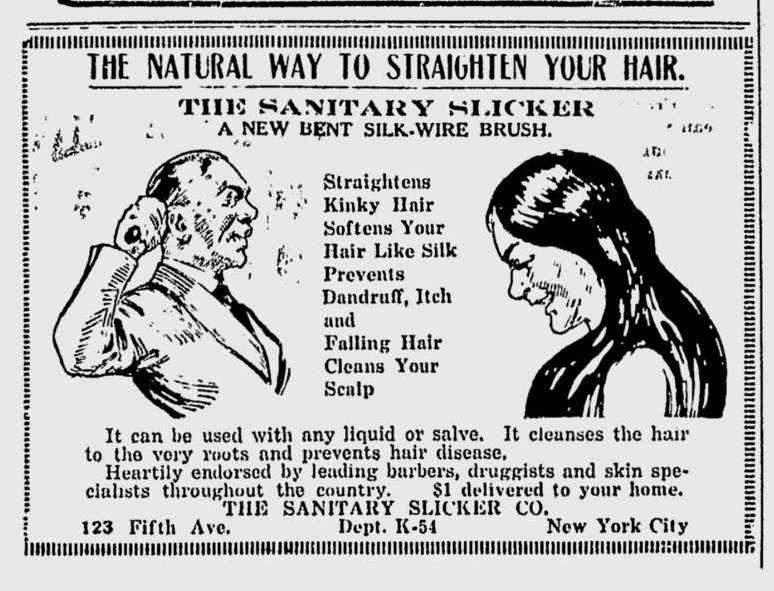1920s
Cosmetic Frame for Bent Legs

The vanished horrors of the past.
Original ad here.
Posted By: Paul - Thu Jun 15, 2017 -
Comments (3)
Category: Technology, 1920s, Differently Abled, Handicapped, Challenged, and Otherwise Atypical
Emperor and Empress of Streeterville

Once upon a time, this couple claimed to own a large chunk of Chicago.
Original story here.



Posted By: Paul - Mon Jun 05, 2017 -
Comments (2)
Category: Eccentrics, Real Estate, 1920s, 1930s
The Sex Detector
The Sex Detector made its debut around 1920. It was a gadget, sold by "Sex-Detector Laboratories," that promised to be able to detect the gender of an egg — or any piece of biological matter whose sex one might want to find out (oysters, butterflies, caterpillars, beetles, worms). It supposedly even worked on blood. So police could use it to discover the sex of a criminal.It was basically an empty rifle shell suspended on a piece of string. When held over an egg (or whatever) it would reveal through the direction of its motion the sex of the chick inside.
It was probably more accurately described as an idiot detector... the idiot being the one holding the string.
For a while it was heavily advertised in poultry journals, but when inspectors at the U.S. Dept of Agriculture investigated the efficacy of the device, they found it to be useless. It worked no better than a piece of cardboard attached to a thread. Advertisements for the product were banned.


Wilmington Evening Journal - May 4, 1928

Williams News - July 8, 1921

San Francisco Chronicle - Oct 17, 1920

St. Louis Post-Dispatch - Feb 5, 1922
Posted By: Alex - Tue Apr 25, 2017 -
Comments (2)
Category: Inventions, 1920s
Mystery Illustration 43

What hideous problem afflicts this man? Halitosis? B.O.? Blackheads?
The answer is here.
And after the jump.
More in extended >>
Posted By: Paul - Mon Apr 24, 2017 -
Comments (5)
Category: Body, Advertising, 1920s
Mystery Gadget 47

What is going on here? Find out at this link.
Or after the jump.
More in extended >>
Posted By: Paul - Mon Apr 17, 2017 -
Comments (6)
Category: Technology, 1920s
Berry Pink, the Marble King
Weird name, unusual hobby.

Original article here.
Home page of current company founded by Berry Pink.
Samples of their marbles, and more history.
Posted By: Paul - Sat Mar 11, 2017 -
Comments (3)
Category: Games, Children, 1920s, 1930s
Chicago Bar Association Annual Musical Revue
Who knew that Chicago lawyers and judges and other legal folks have been doing a theatrical production for nearly 100 years?
Their home page.
The origin story is told in the 1954 review below.
The videos reveal that none of these folks should leave their day jobs.

Posted By: Paul - Wed Feb 22, 2017 -
Comments (0)
Category: Entertainment, Law, 1920s
Roy L. Gray, the Most Average Man
In 1927, William S. Dutton, a writer for American magazine, decided to locate America's most average man. The requirements were that whoever it was had to be:To conduct his search, Dutton used the census report, a map, and a weather chart to select America's most average city, which he decided was Fort Madison, Iowa. Then he conducted a survey of Fort Madison's residents to determine who the most average man living there was.
He finally settled on Roy L. Gray, owner of a clothing store. Gray was 43 years old, married, and had two children.
Dutton knocked on Gray's door and informed him that he was the most average man in America. Gray seemed to take the news in stride. He agreed to an interview, and then was whisked off to Chicago where he was given the VIP treatment, which included getting to meet the mayor. Then he returned to his average life, and as far as I can tell never made the news again.
He should have tried to hook up with Miss Typical.

Rushville Daily Republican - Oct 26, 1927

The Lincoln Star - Oct 25, 1927
Posted By: Alex - Thu Feb 16, 2017 -
Comments (3)
Category: Awards, Prizes, Competitions and Contests, Boredom, 1920s
Artwork Khrushchev Probably Would Not Have Liked 1

Inspired by my earlier post about Khruschev's distaste for modern art, I am moved to launch this occasional series about modern art that was made prior to his premiership (1958) that would have likely offended him. I will focus on less-famous works.
If this is not an esoteric thread, I'm not sure what is!
In any case, we start with "Wrestler," 1929, by Dudley Talcott.
Posted By: Paul - Wed Jan 25, 2017 -
Comments (5)
Category: Art, 1920s, Russia
Akmo Hair Grower

Unlike most patent remedies, there is no information that I can find for Akmo. I wonder what ingredients were in it.
Original ad here.
I assume it could be safely used with this product.

Second ad here.
Posted By: Paul - Wed Sep 28, 2016 -
Comments (0)
Category: Patent Medicines, Nostrums and Snake Oil, 1920s, Hair and Hairstyling

| Who We Are |
|---|
| Alex Boese Alex is the creator and curator of the Museum of Hoaxes. He's also the author of various weird, non-fiction, science-themed books such as Elephants on Acid and Psychedelic Apes. Paul Di Filippo Paul has been paid to put weird ideas into fictional form for over thirty years, in his career as a noted science fiction writer. He has recently begun blogging on many curious topics with three fellow writers at The Inferior 4+1. Contact Us |




